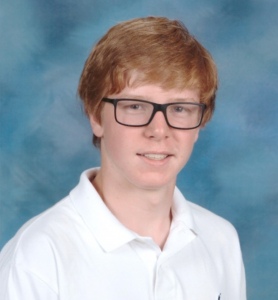In 1997, Greensboro Montessori School held its very first graduation ceremony honoring three eighth grade students. In the fall of 2017, exactly twenty years after that defining moment in the school’s history, we welcomed our inaugural 9th grade class, interestingly enough, also composed of three remarkable students: Theo Fenske, Owen Jacobs and Alex Kotis. It has been affirming to watch these boys step up to be the leaders of the student body of our school. They have each taken on the position with confidence and grace.
To support these students in their new leadership position, this year they have been meeting and interviewing local leaders in the greater Greensboro community. So far the students met with Abu Zaeem, the principal of The Newcomers School and our very own leader, Kevin Navarro, whose dissertation was written about what it means to be a vulnerable leader. Next they meet with Kevin H. Gray, the president of the Weaver Foundation.
Another important element built into our 9th grade curriculum is the completion of a year-long capstone project that challenges each student to apply his or her skills to an area of personal interest that will improve and enhance their world. Similar to a thesis or senior project, the capstone project provides a framework for demonstrating leadership and advanced application of critical thinking skills. The project is comprised of three main components: documented service learning, a written research paper, and an oral presentation, in the style of a TED talk, to the greater school community.
To further extend their learning, the students were challenged to custom design an end-of-year 9th grade field trip that would incorporate research opportunities for each of their individual capstone projects. They have been collaborating with a faculty advisor to explore a range of possibilities, and have settled on an itinerary that involves traveling throughout the Pacific Northwest. Their route will take them to explore tidal pools, tour museums in Seattle, visit a military base in Tacoma and interview refugees in Vancouver.
The three projects are as diverse as the students who developed them and include topics of refugee resettlement, marine ecology and military engineering.
In addition to making steady progress on their capstone projects, the students are taking a full academic course load which fulfills and surpasses the North Carolina state requirements for 9th grade. Their course load includes an honors level English class, an honors level biology class, an online Economics and Civics class, Math 1 or Math 2, and either Spanish 1 or Spanish 2.
So far this has been a productive, busy year for our three inaugural students. As they look ahead at matriculation into 10th grade in fall 2018, they will be well poised for any high school of their choosing whether public, private, charter or otherwise.
Their experience has paved the way for others to follow and their leadership in the realignment of the Upper School (4th-5th-6th and 7th-8th-9th) has reinforced the validity and tremendous benefits of the three-year developmental cycle.
In 2005, Greensboro Montessori School eighth graders first traveled to Costa Rica for a cultural immersion experience. We were eager to connect with another Montessori school abroad with a similar adolescent program. Our research led us to The Summit School in Coronado, Costa Rica which is very close to the capital city of San José. On our first expedition to Costa Rica, we incorporated a formal school visit to The Summit School and it was the highlight of our trip. The parents made a special lunch for us, and our students assisted the younger Costa Rican children with a school project. When we returned the following year, students from The Summit School accompanied our students in our daily travels and service learning adventures. At that point, Greensboro Montessori School and The Summit School became sister schools.
Since then, the eighth grade trip to Costa Rica has morphed into an authentic immersion experience. Our students stay with the Costa Rican families of The Summit School students, and together, our students and the Ticos (a colloquial term for natives of Costa Rica) go everywhere together. We visit volcanoes, complete high ropes courses and sail through the rainforest canopy on zip lines. We travel to the Caribbean Coast where we walk the beach at night looking for turtle eggs to bury in a nearby protected hatchery. We travel to the Pacific side to snorkel and explore rain forests and animal sanctuaries. We spend a day in downtown San José learning about Costa Rican history, art, and government. Our weekends are spent with the host families doing what they usually do. The students also do things you would expect them to do on the weekends: they get together and go to the mall or a movie or a party at someone’s home.
Every year, when asked what our students’ favorite part of the trip is, they always say their homestay with the Tico families. Our students make friendships that last for years, and some even return to Costa Rica on their own to visit their “families.”
In 2009, the Ticos first ventured to Greensboro Montessori School to stay with our students and learn more about North Carolina. Even though we don’t have erupting volcanoes or zip lines through the rain forest, we still have a great time sharing the landmarks and natural wonders of our state with them. Our visits have included such destinations as the Duke Lemur Center, the North Carolina Museum of History, and Hanging Rock State Park. On a recent visit, our itinerary included kayaking on the Dan River, exploring Grandfather Mountain, and a tour of the Duke University Marine Lab in Beaufort. Our homestay hosts always arrange social gatherings for the students on the weekends. The Ticos typically experience some classroom time with us as well as a trip to The Land in Oak Ridge.
Our students benefit tremendously from the life-changing experiences resulting from our relationship with The Summit School. With every visit to Costa Rica, our students return with their eyes a little wider and their lives a little richer as they have their first experience actually living in another culture. They begin to see the world in a different light and develop a new appreciation for the abundance in their lives.
We are pleased to introduce you to Andy King, a member of the Greensboro Montessori School graduating class of 2014 and the founder of our new Alumni Ambassador program. Andy and his family have been deeply connected to our school community since he was very young. He and his two brothers began at GMS when they were toddlers and continued through the primary, elementary and middle school years. Andy is currently a senior at Greensboro Day School and for the last three years, he has consistently received academic honors on the Head's List which recognizes students who maintain an A average (90 and above) on their semester report cards.
Andy is also an accomplished musician and percussionist. He is active in his high school pep band which plays on the sidelines at basketball games to energize the fans and the team. He also enjoys playing in a band with his fellow GMS classmate, Jake Breeden, and GMS faculty members, Jonathan McLean and Doug Williams. The quartet (which goes by the name “Reverend Cleveland and the Graduates”) can be found rehearsing in the evenings in the GMS upper school, and occasionally playing local venues such as Scuppernong Books, churning out a wide variety of instrumental music from jazz to swing.
Outside of school, Andy is an avid mountain biker and sports enthusiast. “I like to mountain bike, not only because it’s exhilarating but because it is a great way to get out in nature. I love to be in nature; it is very calming and helps me feel grounded especially when I am stressed. I am also interested in sports and I play all the time with my family and friends. It is a fun way for me to get exercise. And I enjoy the social aspect of watching sports together with friends.” Andy recently joined the Guilford Gears Composite Mountain Bike Team. The team races against other teams from around North Carolina and recently won 2nd place in a state-wide competition during their inaugural season.
Andy also loves traveling on new adventures. This summer he spent two weeks in Guatemala where he volunteered his time working in rural healthcare clinics. In this service learning expedition, his group assisted medical fellows by testing blood glucose levels and recording vital signs of patients seeking healthcare. Andy also enjoyed spending time with his family this summer in their annual mountain biking trek in Crested Butte, Colorado. “The town has a special place in our hearts as we go every year. The people are always nice, and the natural scenery around the town is stunning. Then we traveled further west to tour Yosemite National Park in California. Without a doubt, it is the most beautiful place I have ever seen in my life!”
As someone who is genuinely kind and insightful, Andy is not shy when sharing about how much he cares for his family. His parents John and Beth King have supported all three of their sons through full educational journeys at Greensboro Montessori School. Andy is the middle of three brothers; his older brother, Aubrey, attends Washington University in St. Louis, MO and his younger brother, A.J., is a 7th grader at Greensboro Montessori School. Andy has a deep respect for the entrepreneurial legacy that began with his great-grandfather at J.A. King company and he has aspirations of joining the family business one day. When asked to share one of his proudest accomplishments, he said, “I recently logged over 300 hours of working as a scale technician at J.A. King company. I started in the summer of 2016, and have loved spending my summers getting experience in the real world and building my knowledge further. This milestone is a way of showing recognition of the work that I have put in, and I am very proud of myself for reaching it.”
Thanks to Andy King for standing tall as a leader and a role model in our alumni community. His hard work and initiative are helping us pave the way for new leadership opportunities for his fellow graduates for years to come.
To my fellow GMS Families,
Welcome to the 2017-18 school year!
The GMS Community Association (GMSCA) is excited and honored to welcome our many new families joining our Montessori community for the first time. We’re also proud to say welcome back to all of our returning families, with a special "hats off" to those pioneering families joining our inaugural ninth grade class. Finally, a special welcome to our new Head of School, Kevin Navarro, and his family. We are excited about the enthusiasm Kevin has already put into building the partnership between our parent community and our administrative and teaching staff. It’s a wonderful time to be at GMS!
Our hope is that every family will find value in the GMSCA. Our mission is inclusion; inspiring an engaged community of friends who support and encourage each other as parents. We also strive to recognize the diversity of contributions we collectively bring to our school.
Unlike most other schools, membership in the GMSCA is automatic….and free! We ask for no dues and we do not ask you to sell anything. Our activities are funded through a variety of ways, mainly the fall and spring book fairs. We also raise funds through initiatives like the Harris Teeter Together in Education VIC Card Program, so please let’s get those cards linked to our school (link to #1849)!
Perhaps the most visible way you will see the GMSCA in action is through the events we plan and support throughout the school year. Three of the largest are:
- The Fall Festival - a free family-centered weekend event with dozens of activities for kids of all ages.
- The International Fair - an amazing event highlighting our community’s cultural diversity through music, food, art and fun.
- The Green & White Bash - an adults only social event that gives us the opportunity to get to know each other better and raise some money to support our school.
Beyond events, we also provide opportunities for you to participate in the overall experience for your children. The GMSCA supports room parents who work directly with your teachers and help coordinate other parent volunteers needed to plan and execute many of the fun and educational activities your children love. The GMSCA virtual community page on Facebook is available to all parents to connect from home, the office or after hours. We also host social opportunities like morning coffees and Parents’ Nights Out.
In closing, thanks so much to the many parents who participate in the GMSCA. We’re always looking for more parent and community involvement and would love to have your talent on our community team. You don’t need to attend a meeting, host an event, or take a day off work to volunteer to be an essential member of our community.
Here are a few ways you can contribute right now:
- Attend our first Community Garden Workday on Saturday, September 16. We will have a variety of needs that day as we reimagine our Upper School Garden. All ages and abilities welcome!
- Plan to volunteer one morning or afternoon for our Scholastic Book Fair October 6 through 13. The monies raised from the book fair go directly to the GMSCA and allow us to fund things like the Fall Festival and Teacher Appreciation Week celebrations.
- Look for the sign-up genius coming soon with opportunities to volunteer at the Fall Festival on Sunday, October 8. It takes a village to have a successful and fun event. And this year the GMSCA will be purchasing all of the supplies so we are simply looking for donations of your time.
We’re looking forward to a wonderful year for our school, our community and, most of all, our children.
See you at school!
Cordially,
Karen Kelly, 2017-18 GMSCA Lead Coordinator
"An Education for Life," has become a marketing catchphrase in education. What was first coined by Dr. Maria Montessori and unique to her research-based approach, is now overused to the point of meaninglessness. But rather than give up on Dr. Montessori's philosophy, let's explore it's origin and provide the context needed to rescue this phrase from educational pop culture.
In 1949, Dr. Montessori wrote "The Absorbent Mind" based on her decades of childhood research. She writes of her pedagogical theory: "This is education, understood as a help to life.” Dr. Maria Montessori applied a scientific technique to the observation of natural development in students and concluded there are a number of important concepts concerning childhood growth and development:
- Optimum growth is affected by the environment. Dr. Montessori observed that growth can be enhanced by the environment in which the child grows.
- Growth occurs in spurts. Dr. Montessori observed that growth occurs in stages which have peaks and valleys. She called these stages “planes of development.”
- Childhood has distinct characteristics. Dr. Montessori observed that children are not “little adults.” The process of growth during childhood is unique and like no other time during the human lifespan.
- Intelligence increases with experience. Dr. Montessori observed that intelligence grows with experience, and the key to developing the intellect is to promote the constructive activity of the child.
- Each child has a unique potential. Dr. Montessori observed that the child did not come as a clean slate and then
became a product of his cultural experiences. She believed that the child has innate tendencies to become human with a
vast potentiality that was largely wasted in conventional education. - Education is needed to serve the child and not just the needs of society. Dr. Montessori observed that education must place its greatest energies towards serving the child for the betterment of society and the evolution of humankind as a species.
- Children love to learn. Given an optimal environment with adults educated about the true needs of the developing
child, Dr. Montessori observed that children pursued knowledge with vigor and enthusiasm. The classic method of
rewards and punishment are obstacles to the child’s healthy growth and interest in learning. The structure of the Montessori method provides freedom within limits which enhances the learning experience for the child and builds within him an intrinsic motivation to succeed. - Education for development. The Montessori method structures education to meet the developmental needs of the
growing child without preconceived curricula or a directive approach. This she called an education for life.
An Education for Life. When you hear this phrase in our hallways, know it's not some quip or expression resulting from a focus group. It is tenet of the Montessori method highlighting the dual role of education: to meet the child where she is in her developmental growth and to prepare the child for that which lies ahead.
Greensboro Montessori School sends tremendous congratulations and a fond farewell to our class of 2017. In our lead photo for this post, the class of 2017 stands proudly in the top row. Pictured from left to right are Isabel Egbert, Jean-Lou Paré, Jack Brown, Sophie Strugnell, Baxter Smelzer, Simon Smith, Eli Wainscott, Ya Chukasul, and Hayden Juneau. The inaugural ninth-grade class, who will return next year, kneels along the bottom row. Pictured from left to right are Alex Kotis, Owen Jacobs and Theo Fenske.
[dt_sc_h2] Sound Bites from the Class of 2017[/dt_sc_h2]
Greensboro Montessori School's graduation exercises include personal speeches from the graduates. In these moments, the audience is treated to glimpses of each graduate's past, present and future. In honor of these young adults' self-awareness, maturity, accomplishments and gratitude, we share some of the most touching thoughts shared by the class of 2017. Photos courtesy of Aris Wells Photography
[dt_sc_h5]Jack Brown[/dt_sc_h5]

"I have only been at Montessori for three years, but I have gotten the experience of a lifetime. I can say, without a doubt, that this Montessori experience will put me ahead all throughout my life. First of all, I'd like to thank my parents for sending me to this school...Like all things in life, things come and go away, sometimes even too quickly. And when I found my grade the oldest one in Montessori, I knew it had been too quick. Although I have been dreading leaving this school, I am also looking forward to the upcoming year."
Jack's next stop: Grimsley High School
[dt_sc_h5]Ya Chukasul[/dt_sc_h5]
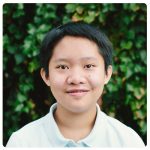 "Now Middle School. Nothing has changed a lot about me; I'm still quiet as I could ever be. Old friends were still there for me, so I felt safe. Things changed here though. Assignments got more difficult and [there were] projects I thought I would never be able to do. From creating a wolf suit on stilts, to creating costumes, to creating a movie. Teachers in Middle School: Jonathan, Doug, Deirdre, Dean, Jenny, Sandra, Matt and Keisha. Without your help, I wouldn't be on this stage today. Middle School felt just like family."
"Now Middle School. Nothing has changed a lot about me; I'm still quiet as I could ever be. Old friends were still there for me, so I felt safe. Things changed here though. Assignments got more difficult and [there were] projects I thought I would never be able to do. From creating a wolf suit on stilts, to creating costumes, to creating a movie. Teachers in Middle School: Jonathan, Doug, Deirdre, Dean, Jenny, Sandra, Matt and Keisha. Without your help, I wouldn't be on this stage today. Middle School felt just like family."
Ya's next stop: Weaver Academy for the Performing and Visual Arts and Advanced Technology
[dt_sc_h5]Isabel Egbert[/dt_sc_h5]
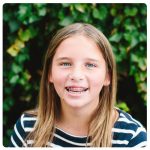
"Before I do anything, I need to thank my family. Grant, you made me who I am in ways you can't even understand. You are always there for me, and I love you. Mom and Dad, thank you for putting me in this school and for supporting me in everything I do...Eighth grade is a confusing, scary fever dream. Everything stops being just a thing and becomes your last thing. Your last Marketplace; your last Land trip; your last Advisory; [your] last time in CASA; until finally, you're standing here for the last time. Thank you all for everything."
Isabel's next stop: Weaver Academy for the Performing and Visual Arts and Advanced Technology
[dt_sc_h5]Hayden Juneau[/dt_sc_h5]
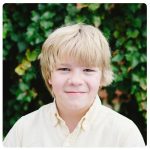
"In his final year at this school, this kid, alongside his partner in crime, Owen Jacobs...started to run everything tech related, doing things like being the first students to run [theatrical productions] by themselves. This kid, in his final year, found out what he wanted to be. He found out what he was skilled at, and here he is, standing on a stage, the last day he will be a student here, telling you about the last three years of his life in the third person. How - meta - is - that?"
Hayden's next stop: Weaver Academy for the Performing and Visual Arts and Advanced Technology
[dt_sc_h5]Jean-Lou Paré[/dt_sc_h5]

"It took a little bit of time to adjust to the new homework load, but once I got past that, I had lots of fun in Jonathan's long-term [creative labs] projects, Dean's science labs, and Doug's math classes. I also had a blast at the land helping the Racoon tribe set up the Tipi, make a fire, and the fun job of washing dishes. I also enjoyed the woodworking rotation...Thank you to everyone that has helped make my experience at GMS the best it could be and making it possible for me to attend the STEM Early College next year."
Jean-Lou's next stop: STEM Early College at NC A&T State University
[dt_sc_h5]Baxter Smelzer[/dt_sc_h5]
"After 12 years of the Greensboro Montessori School, I am definitely going to miss it. Leaving can be a scary and an exciting time. And I have had not only amazing relationships with friends throughout the years, but also with the teachers. You couldn't ask for more involved and caring teachers. Teachers, staff, and friends all in [an] awesome Montessori environment that all helped me grow to be ready for the next step in my life. After being here, I look around and realize I am ready. I have been well prepared and have learned the skills I need to move forward."
Baxter's next stop: Page High School (pre-IB) or Weaver Academy for the Performing and Visual Arts and Advanced Technology
[dt_sc_h5]Simon Smith[/dt_sc_h5]

"I have spent..12 years of my life in this school and sometimes I gotta ask, 'Is this the real life or is [it] just fantasy?' This school has been amazing to me from the teachers to the staff, and this place has most definitely given me its all...A little known fact about me..I don't like change. But life forces you to change whether you like it or not...You just have to adapt."
Simon's next stop: Weaver Academy for the Performing and Visual Arts and Advanced Technology
[dt_sc_h5]Sophie Strugnell[/dt_sc_h5]

"My experience at GMS has definitely been special...Learning in [a] Montessori environment is a lot more free. There aren't as many guidelines, and it's more based around genuine curiosity. I think in Montessori there are a lot more lessons that are being learned, and there are a lot of life skills that are involved. I've really enjoyed my time here and have made many memories with many people. Even though I've only been here one year, I'm gonna miss everyone so much, but I'm excited to see what's in store for me next."
Sophie's next stop: Northern Guilford High School
[dt_sc_h5]Eli Wainscott[/dt_sc_h5]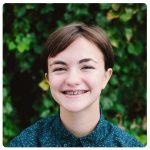
"My final word describes my Middle School experience is 'nuevo,' which means 'new' in Spanish. Everything is new here. You are thrust into projects and situations that you've never experienced before, and it's blissfully confusing to figure it out, solve the puzzle, get rid of the grit on the lens to see the full picture. I've done it all now, however. I've planted microgreens; I've led a group to be saved by aliens; I've branched out to new people, new groups of people; and I've learned by this. By every moment, every decision, I've grown as a person."
Eli's next stop: Weaver Academy for the Performing and Visual Arts and Advanced Technology
<hr>
[dt_sc_h2]Looking Ahead to the Class of 2018[/dt_sc_h2]
In 1997, Greensboro Montessori School graduated its first class of three eighth-grade students. It seems fitting on the 20th anniversary of that historic occasion, we are proudly introducing the School's first class of ninth-grade students, and it is also comprised of three students. Greensboro Montessori School is proud to announce the intelligent, talented, creative and courageous young men who are boldly pioneering the School's ninth-grade program.
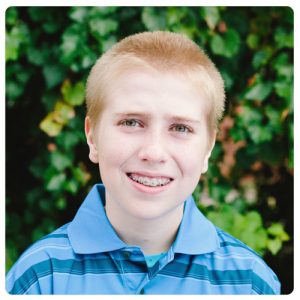
Theo Fenske
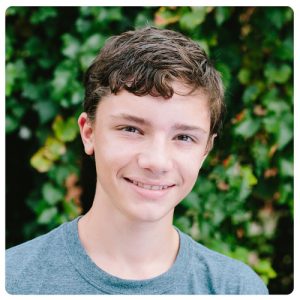
Owen Jacobs
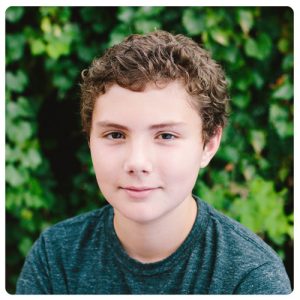
Alex Kotis
If you stroll through our school gardens on any given Monday afternoon, you are likely to find Marcia Jones volunteering alongside our lead environmental educator, Eliza Hudson. As a retired educator, Marcia looks forward to her weekly gardening class with our Primary students, and with her 31 years of experience as a kindergarten teacher in Guilford County, we look forward to all she has to offer the children and the school. In a recent interview, Marcia shared with us how much she loves teaching young children the value of tending the earth, especially her four grandchildren including Foster, who is enrolled in our Primary program.
In addition to helping in our gardens on a weekly basis, Marcia supports several other community gardening projects in and around the Greensboro area. She uses her green thumb to tend the gardens at the Wentworth Museum in Rockingham County, the Guilford College Community Garden and Jones Elementary School. “Gardening helps me relax,” Marcia shared, "and its so nice to be able to see the product of all your effort. I think that’s especially true for young children." Many years ago, she started a gardening program with her kindergarten students at Sedgefield Elementary School. “The children loved it. We grew a wide variety of vegetables from seed, including squash, radishes, potatoes, peas, and pumpkins. The children especially liked the pumpkins because they would grow all summer and could be harvested in the fall,” she shared.
With her family’s roots in this area of North Carolina, Marcia is deeply connected to the land, and her knowledge of farming is much greater than what her humble demeanor might initially suggest. She grew up working on her family's farm in Rockingham County just north of Greensboro and she has many fond memories of driving the tractor out in the fields. “My sister and I were working on the family farm up until two years ago. Over the years, we’ve grown tobacco, corn, wheat, soybeans and apples.” Even with those years of experience in her back pocket, Marcia continues to express her modesty about having a green thumb and loves learning new gardening techniques from those around her. “Lately, I’ve been learning more about which herbs to plant around my vegetable garden to deter deer and other wild animals,” she told us.
We recently began a discussion on the quintessential similarities between computational thinking and the Montessori method. The three-part blog series is inspired by a recent New York Times article by Laura Pappano entitled “Learning to Think Like a Computer.” In our first post, we explained how even the simplest of Montessori materials teaches computational thinking skills. In this second installment, we highlight how the Montessori approach to education develops computational thinking within students.
We met with Jonathan McLean to talk about his semester-long assignment in the Middle School’s Creative Labs course. Like all classes in the Montessori curriculum, this visual and performing arts class integrates subject matter from other areas of study. More specifically, Jonathan is weaving together STEM (Science, Technology Engineering and Math) and Art History through a complex science fiction role-playing game involving student-built robots and drones. To make sense of the story and succeed in the game, Jonathan’s students must employ computational thinking skills.
Just what are these skills? In her New York Times article, Laura Papanno says they are “recognizing patterns and sequences, creating algorithms, devising tests for finding and fixing errors, reducing the general to the precise and expanding the precise to the general.”
Our middle school students are flexing all these mental muscles in a battle royale between the Drones and the Bots, the only remaining cultures in the elaborate story guiding this semester’s coursework. The setting is such: The Earth has overheated making it inhabitable for organic life. Only two warring cultures, Bots and Drones remain, but neither are safe. Volcanic activity threatens the Bots on land and atmospheric change jeopardizes the Drones in air. The Bots and Drones must appeal to an Alien culture to save them, and it just so happens the Aliens have tremendous reverence for the visual arts. As the Bots and Drones compete for the Aliens’ benevolence, they must do so with aesthetically appealing design and decoration which aligns with the Aliens’ favorite artistic movements.
As the facilitator, Jonathan plays the role of the Alien culture. The students are divided into multi-age teams aligned with either the Bot or Drone culture. Jonathan gives the students data sets with which to design, build and operate their Bots and Drones. The teams consist of students in the various rolls such as officer, designer, engineer and pilot. As the students receive, process and make sense of the data they receive, they must adapt to survive. Whether either or both cultures escape the Earth will be determined in a three-hour Bot versus Drone showdown next week. The teams’ performances are the students’ final exam for the class (and Jonathan has a surprise finale planned for the students if they find a win-win solution for the Bots and the Drones).
Rather than dictate or force rote memorization upon their students, Montessori teachers educate through integrated experiences. Jonathan has created a fictional and engaging theme to provide a framework in which the students are able to apply real-world skills. Students are absorbing data from multiple sources to identify problems, understand the scope of the problems and develop and test solutions. Additionally, Jonathan is purposefully withholding information forcing the students to uncover new information and draw conclusion on their own. Harkening back to Laura Pappano’s words about computational thinking: “Concealing layers of information makes it possible to get at the intersections of things, improving aspects of a complicated system without understanding and grappling with each part. Abstraction allows advances without redesigning from scratch.”
If all of this sounds like a lot of fun, it is. Our middle school students are learning science, technology, engineering and math in their visual and performing arts class. If a student loves art, he can pursue this interest through the final appearance of his Drone, but he must also ensure aesthetic enhancement doesn’t impact physical performance. On the contrary, if a student loves engineering, she can fuel her curiosity through building her Bot, but the structure must accommodate one of the Aliens’ preferred art movements, for instance, Cubism.
In most schools throughout the country, these two students couldn’t thrive in the same class, but the Montessori method demands they both succeed by allowing them to pursue their passions through integrated curriculum and independent study. No single class takes place in a vacuum of learning, and students must carry their knowledge and experiences from one class to another. Ultimately, it’s learning how to think (like computational thinking skills), versus what to think which prepares these students for a lifetime of achievement.
We recently had the pleasure to do a personal interview with our GMSCA outreach coordinator, Rebecca Sheridan. Becca is such a down to earth and approachable person, and we are eager for you to meet her, in case you haven’t already. We also wanted to learn more about how she is enjoying her first year working with the GMSCA cultivating the Outreach Committee!
In a recent article in the New York Times titled "Learning to Think Like a Computer," author Laura Pappano mentions the need for students in all disciplines to understand and practice “computational thinking.” She defines these skills as “recognizing patterns and sequences, creating algorithms, devising tests for finding and fixing errors, reducing the general to the precise and expanding the precise to the general.” As I read through the article, I thought of the scientific Montessori materials used daily in our classrooms that give our students experiences with these skills. From the time they are toddlers, Montessori students are challenged to identify patterns, follow sequences, and recognize errors in their own work.
At its most basic level, the layout of a Montessori classroom is designed to aid the recognition of patterns and sequences. The shelves are organized neatly from top to bottom and from left to right, reinforcing the same orientation with which we read. On a deeper level, the materials themselves are designed to appeal to the senses and entice curiosity and repetition, thereby enhancing the young child's ability to directly compare, contrast and discover the patterns and sequences inherent in the environment. Dr. Maria Montessori once said, “The education of the senses has, as its aim, the refinement of the differential perception of stimuli by means of repeated exercises.” It is through these independent, repeated exercises that children gain this deep perception of patterns that exist in the world around them.
In traditional educational settings, children go to school and do work that is prescribed by the teacher. Lessons that employ Montessori materials are teaching students to think through a complex algorithm of steps each time they independently take an activity off the shelf: selecting the activity, identifying and following each step of the activity, completing the task at hand, and then returning the work to its space on the shelf. The child then has the freedom to create his or her own algorithm in how the material can be used effectively. Each material has variations and extensions (new steps in the algorithm) that can be shown by the teacher guide, or more often, discovered by the student. This logical process is applied across all areas of the curriculum.
In addition to thinking through algorithms, learning to devise tests for finding and fixing errors is another aspect of computational thinking. Dr. Montessori was intentional about creating learning materials to “provoke auto-education," in other words, materials that were self-correcting. In this way, the child could experiment with a material and deduce the correct answer through trial and error, rather than having the teacher validate the correct answer. “Indeed, it is precisely in these errors that the educational importance of the didactic material lies.” (The Montessori Method, p. 171) Devising tests for finding and fixing errors is an essential element the Montessori method of education.
Another skill listed as essential to computational thinking is reducing the general to the precise and expanding the precise to the general. The Montessori math materials are the best example of the student’s ability to breakdown abstract concepts into concrete examples and vice versa. From the start, the red and blue rods in the Primary classroom allow a child to explore the concept of one to 10 with his or her hands. Also, an exploration of the introductory golden bead tray involves realizing that the 10-bar is made up of 10 single unit beads, the 100-square is comprised of 10 10-bars, and the thousand cube is comprised of 10 100-squares. This understanding of place value and quantity is further reinforced by its relationship to the geometric forms of a line, square and cube.
My favorite example of how the materials demonstrate the connection between precise and general, or concrete and abstract, is in the math bead cabinet. In the Primary classes, the student uses the square chains to physically count one-by-one up to the square of each number, then uses the cube chains to count to the cube of each number (i.e., the cube chain of threes counts to nine, and the cube chain of threes counts to 27). In Elementary classes, the chains are then used for skip counting (e.g., three, six, nine, 12, 15, etc.), which becomes a lesson in multiples. Studying multiples provides a peek into the abstraction of pre-algebraic formulas.
So far we’ve explored some of the ways the Montessori materials are leading children to develop computational thinking. In Part Two of this three-part series, we will interview Jonathan McLean about how our sixth, seventh and eighth level students are applying computational thinking in his Creative Labs course in the Middle School.

